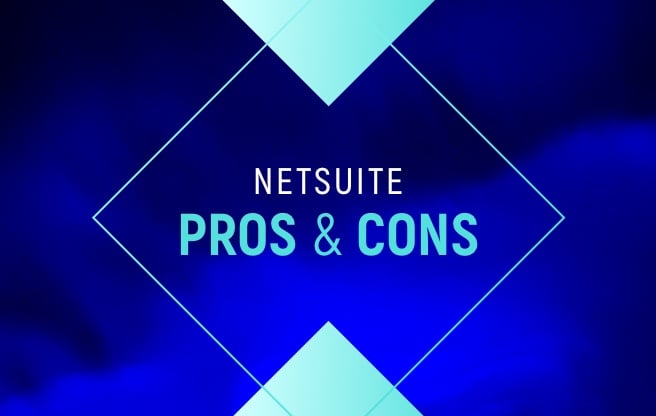For small and mid-sized businesses (SMBs) seeking a reliable ERP solution, Oracle NetSuite and SAP Business One (B1) are two popular choices. While both platforms aim to centralize business operations and improve efficiency, their fundamental differences in architecture, scalability, and long-term viability often make one a better fit than the other, depending on the business’s goals.
NetSuite has established itself as a cloud-native ERP leader, offering unmatched scalability and a unified platform that grows with your organization. In contrast, SAP Business One, a solution with a 20-year history, was designed primarily for on-premises deployment but has recently transitioned to hosted cloud options. While affordable at first glance, SAP Business One can present challenges in scalability, integrations, and customizations, often resulting in higher total costs over time.
This article focuses on NetSuite vs SAP Business One. For a broader comparison, visit our NetSuite vs SAP guide.
Key Differences Between Oracle NetSuite and SAP Business One
Financial Management
NetSuite: NetSuite’s financial management tools are built to handle complex business structures, offering multi-company financial consolidation, intercompany netting, and real-time reporting. Features like OneWorld simplify operations for companies managing multiple subsidiaries, currencies, or international entities. The platform also automates depreciation and fixed asset management, saving valuable time for accounting teams.
SAP Business One: While SAP Business One includes core financial features like accounts payable and receivable, it struggles with more advanced requirements. There’s no built-in support for financial consolidation, forcing businesses with multiple entities to purchase additional applications or rely on partners for manual solutions. Additionally, users cannot edit or remove financial transactions, and fixed asset depreciation must be handled outside the system, limiting automation.
SAP Business One also requires separate databases for each subsidiary, which can complicate financial consolidation processes. Businesses often resort to third-party tools for consolidations, which introduces additional costs and delays real-time insights. Additionally, SAP’s batch-processing method limits access to live financial data, making decision-making less agile compared to NetSuite’s real-time capabilities.
NetSuite’s unified database eliminates these hurdles, providing built-in financial consolidation and the ability to drill down into transaction-level details for multi-subsidiary organizations. This makes NetSuite particularly advantageous for CFOs managing complex global operations.
Operational and Supply Chain Management
NetSuite: NetSuite’s suite of modules for inventory management, demand planning, warehouse management, and manufacturing integrates seamlessly, providing businesses with real-time insights across their supply chain. The Demand Planning module enables businesses to create accurate production plans, ensuring optimal inventory levels and minimizing waste. NetSuite’s Warehouse Management System (WMS) further enhances operational efficiency by streamlining warehouse activities, improving productivity, and reducing inefficiencies.
NetSuite also excels in providing broad supply chain visibility, enabling businesses to adapt quickly to changes in market conditions. Its cloud-based, real-time architecture allows companies to make data-driven decisions and respond proactively to demand fluctuations, making it a robust solution for organizations with complex or fast-moving supply chains.
SAP Business One: SAP Business One is particularly appealing to smaller manufacturers, retailers, and distributors due to its native material requirements planning (MRP) and inventory management features. For highly specialized manufacturing needs, such as engineer-to-order (ETO) or advanced MRP capabilities, SAP Business One delivers deeper functionality out of the box. This makes it a solid choice for businesses that require niche manufacturing processes.
However, SAP Business One often falls short in areas like warehouse management and advanced manufacturing. Many businesses need to rely on third-party tools to address gaps in functionality, adding complexity and costs. Additionally, the system’s scalability limitations may hinder its ability to support larger or rapidly growing organizations with complex supply chain requirements.
Reporting and Analytics
NetSuite: NetSuite’s SuiteAnalytics delivers advanced reporting and analytics capabilities. Users can create custom dashboards and drill down from high-level metrics to detailed records in real time. The built-in reporting functionality ensures businesses have access to the insights they need without purchasing additional tools.
SAP Business One:SAP Business One’s reliance on Crystal Reports, a legacy tool requiring technical expertise, often necessitates external consultants for setup and ongoing maintenance. Additionally, the absence of native real-time analytics limits the ability of organizations to make data-driven decisions quickly. Businesses seeking advanced analytics may need to purchase SAP Analytics Cloud, further increasing costs.
NetSuite eliminates these challenges with SuiteAnalytics, providing users with drag-and-drop report building, customizable dashboards, and real-time financial consolidation. Its modern reporting tools empower users of all skill levels to access actionable insights without relying on external consultants.
Scalability and Growth
NetSuite: As a cloud-native solution, NetSuite is designed to scale with businesses of all sizes, from startups to enterprises managing billions in revenue. Its multi-tenant architecture ensures that companies can grow without reimplementation, and updates are applied automatically across all customers.
SAP Business One: Business One is best suited for smaller organizations with simpler needs. For companies experiencing rapid growth, it may struggle to scale effectively, particularly in multi-subsidiary environments. Businesses often find themselves migrating to more advanced SAP solutions, such as S/4 HANA, which can be expensive and disruptive.
SAP Business One struggles to scale effectively in organizations with more than 50 users or in complex multi-subsidiary environments. Businesses often experience slow database access and unresponsive interfaces as user numbers grow. Supporting a large number of remote users may also require costly hardware investments, such as additional communication servers.
In contrast, NetSuite’s cloud-native design is inherently scalable, allowing businesses to handle increased users, subsidiaries, and operational complexity without reimplementation. This ensures organizations can grow seamlessly while avoiding disruptive and costly migrations to advanced SAP solutions like S/4 HANA.
Deployment and Architecture
NetSuite: NetSuite’s multi-tenant SaaS platform ensures accessibility from anywhere, with no need for on-premises infrastructure. The system’s architecture integrates all modules seamlessly, eliminating the need for complex integrations or middleware.
SAP Business One: SAP Business One offers on-premises, hybrid, and hosted cloud deployment options, which may appeal to organizations that prefer to retain local control of their infrastructure. However, its hosted cloud model relies on adaptations of its legacy on-premises design, requiring third-party tools like VPNs for remote access. This approach can increase complexity and reduce flexibility compared to NetSuite’s cloud-native architecture.
For organizations with compliance or data sovereignty concerns, NetSuite provides solutions through its global network of data centers, ensuring security and accessibility across borders.
Customization and Flexibility
NetSuite: NetSuite offers flexible customization through its SuiteCloud platform, enabling businesses to tailor workflows, dashboards, and reports with ease. SuiteCloud’s user-friendly tools, such as SuiteScript and SuiteFlow, allow organizations to adapt the system to their unique needs without requiring extensive technical expertise. These built-in capabilities empower teams to manage customizations in-house, reducing dependency on external consultants and keeping costs predictable.
NetSuite’s unified architecture ensures that all customizations remain intact during system updates, eliminating the need for additional rework or disruptions.
SAP Business One: SAP Business One supports customization but often relies on third-party tools and proprietary Software Development Kits (SDKs), such as BODL and ABSL. These SDKs require specialized knowledge, which can make it more challenging and costly for businesses to implement changes or adapt the system to meet evolving needs. Many customizations also depend on external consultants, increasing both time and expense.
Additionally, customizations in SAP Business One are not always seamless during upgrades, leading to potential compatibility issues or the need for reimplementation, which can disrupt business operations.
Which Industries Are Best Suited for NetSuite vs. SAP Business One?
NetSuite: NetSuite’s versatility and scalability make it an ideal choice for a wide range of industries, particularly service-oriented businesses, multi-subsidiary organizations, and companies operating across global markets. Its advanced financial management tools, real-time analytics, and seamless integration capabilities are especially beneficial for professional services, software companies, wholesale distributors, and e-commerce businesses.
NetSuite’s ability to handle complex multi-entity operations, including advanced financial consolidation, intercompany accounting, and global compliance, positions it as a top choice for businesses planning rapid growth or expansion.
SAP Business One: SAP Business One is particularly well-suited for smaller manufacturers, retailers, and distributors with niche operational needs. Industries such as manufacturing benefit from its native support for engineer-to-order (ETO), material requirements planning (MRP), and basic inventory management. Its affordability and straightforward functionality make it a practical option for small businesses with simpler operational requirements and limited IT resources.
However, for industries requiring advanced reporting, supply chain optimization, or multi-entity management, SAP Business One may struggle to meet growing demands without significant customizations or upgrades.
System Integration Capabilities
NetSuite: Both ERP systems offer integration options, but NetSuite’s SuiteCloud platform provides over 500 pre-built integrations with popular business applications, ensuring a seamless and scalable connection between systems.
SAP Business One: SAP Business One, by comparison, lists only 69 apps in its AppCenter. Many integrations require partner involvement and custom development, increasing complexity and cost. Additionally, SAP Business One’s reliance on proprietary SDKs like BODL and ABSL can make finding skilled developers a challenge.
Module Comparison: NetSuite vs. SAP Business One
The table below highlights the core and advanced modules available in NetSuite and SAP Business One. While both platforms cover essential ERP functionalities, NetSuite offers a broader range of integrated modules, especially for advanced business needs.
.png?width=1920&height=1080&name=NetSuite%20Edition%20Comparison%20(6).png)
Pricing Comparison
.png?width=884&height=497&name=NetSuite%20Edition%20Comparison%20(5).png)
SAP Business One’s entry-level pricing may appear more affordable initially, particularly for smaller organizations opting for perpetual licenses. However, the hidden costs of licensing adjustments, upgrades, and partner-dependent customizations can significantly inflate the Total Cost of Ownership (TCO) over time.
SAP Business One and NetSuite Pros and Cons
NetSuite Pros:
- Cloud-native architecture ensures automatic updates and scalability.
- Comprehensive financial features, including advanced multi-entity management.
- Built-in reporting and analytics with real-time, drill-through capabilities.
- Seamless integration across modules without middleware or third-party tools.
NetSuite Cons:
- Higher initial implementation costs.
- SMBs with basic needs may find its advanced features excessive.
SAP Business One Pros:
- Affordable entry-level pricing for smaller businesses using perpetual licenses.
- Native support for basic MRP and inventory management.
- Integration with SAP tools like Ariba and SuccessFactors.
SAP Business One Cons:
- Limited scalability for growing businesses or complex organizations.
- Hosted cloud model requires third-party tools and increases complexity.
- Customizations and reporting often rely on external consultants or additional software.
Verdict: Which ERP Is Best for You?
NetSuite is the ideal solution for SMBs and mid-market companies planning for long-term growth. Its cloud-native architecture, advanced financial management tools, and robust scalability make it particularly well-suited for fast-growing organizations or those with multi-subsidiary operations.
SAP Business One is a viable option for smaller businesses in manufacturing or distribution that need an affordable entry point into ERP. However, its limitations in scalability, hosted cloud model, and reliance on third-party tools may hinder businesses with more complex needs.
Best For:
- NetSuite: CFOs and CIOs prioritizing scalability, advanced financial management, and real-time analytics.
- SAP Business One: Controllers and IT Directors at smaller manufacturing or distribution businesses with simpler operational needs.
Conclusion
Choosing the right ERP system is a pivotal decision that directly impacts your business’s efficiency, scalability, and ability to adapt to future growth. In this blog, we explored the key differences between NetSuite and SAP Business One across financial management, supply chain operations, customization, scalability, and pricing.
While SAP Business One provides a cost-effective entry point for smaller businesses with simpler needs—especially in niche manufacturing scenarios—it faces limitations in scalability, integrations, and long-term viability due to its reliance on legacy architecture and third-party tools. Hidden costs, such as those for upgrades and customizations, can also significantly inflate the Total Cost of Ownership (TCO).
On the other hand, NetSuite emerges as the superior choice for SMBs and mid-market companies planning for sustained growth. Its cloud-native architecture, comprehensive suite of built-in modules, and robust financial management tools enable businesses to streamline operations and scale effortlessly. With advanced features like OneWorld for global operations, SuiteAnalytics for real-time insights, and SuiteCloud for seamless customizations, NetSuite is particularly well-suited for fast-growing organizations with complex or multi-subsidiary structures.
At Techfino, we understand that every business has unique needs. Our team of ERP experts is here to help you evaluate your options, customize solutions, and ensure a smooth implementation tailored to your goals. Contact us today to take the next step in your ERP journey and empower your business with the right tools for success.
Get Started Now
The easiest way to get started is to contact Techfino today. If you’d like a little more information first, you can download our ContinuedSuccess Whitepaper. Either way, we hope you’ve found this guide helpful and hope that we can further assist you on your path to leveling up your NetSuite Support.



